







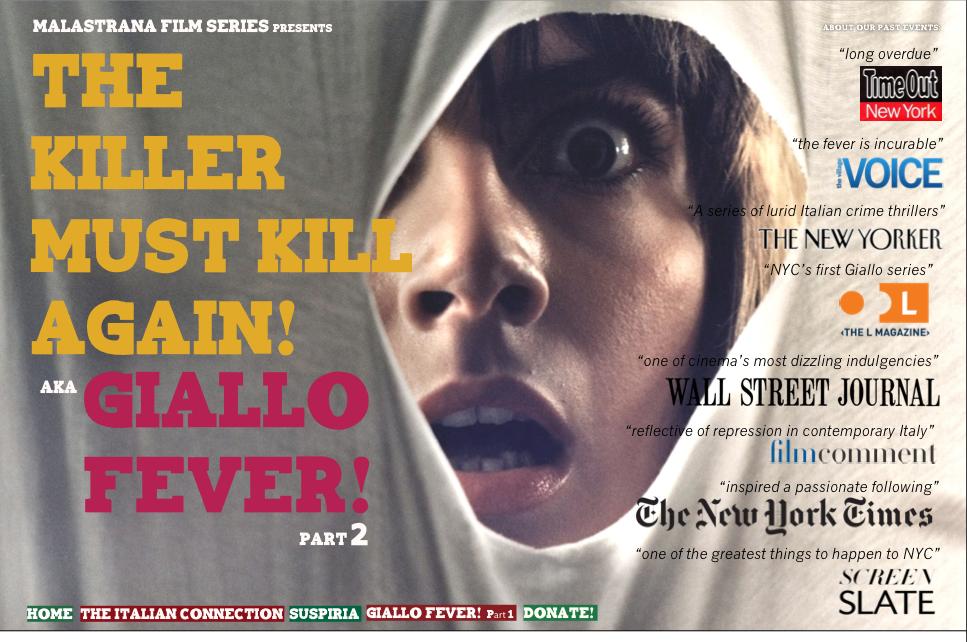
If you’re like us, then you don’t really need an introduction to the giallo. You’ve had the Giallo Fever series at Anthology Film Archives on your calendar for months; you’ve also probably watched one or two of these movies in the past week to get in the spirit of the series. However, all movies are best experienced with friends, and not everyone gets excited for poorly dubbed Italian thrillers the way that we do. If you want to convince your friend or significant other to join you at the Anthology Film Archives next week, or finally dive into the Mario Bava collection on Amazon Prime, let this be your handy guide. We might just be able to hook ‘em in on your behalf.

It’s probably not a stretch to say that genre film would be considerably less interesting without the influence of 1960s and 1970s Italian directors. For two decades, Italian filmmakers such as Dario Argento, Mario Bava, Sergio Martino, and Lucio Fulci used American genre films as a springboard for new heights of violence and gore. The frontier antihero spawned the “Spaghetti” Western; the renegade cop became the poliziesco or police thriller; and the psychosexual violence of PYSCHO became the giallo, a genre focused on sexually ambiguous serial killers whose popularity today is back on the rise.
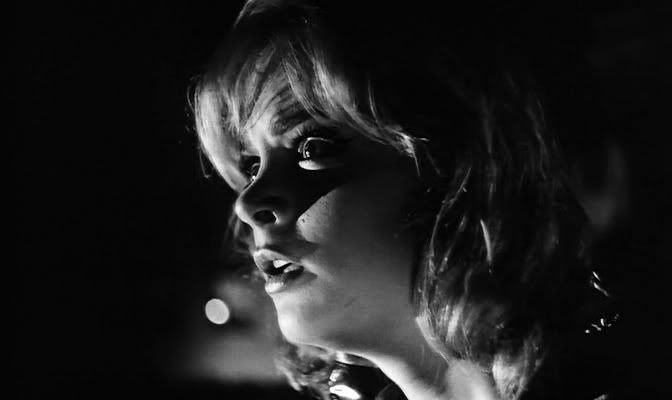
Named after the yellow covers of murder mystery novels, the giallo serves as an important link between crime thrillers and American slasher film of the ‘70s and ‘80s. Like the crime thriller, many of these films feature an amateur murder investigation by someone who either witnessed or has a personal connection to the crime. These protagonists – often writers and journalists, people with a knack for asking questions and no lack of money and free time – work with local experts to unravel the crime until they themselves become a target of the killer. If they’re lucky, only the helpful expert will get killed. If not, no one is safe.

Unlike the crime thriller, however, the giallo has no real interest in presenting audiences with a solvable mystery. Like the cheap paperbacks that inspire its name, the giallo was meant to titillate, blending together sex and murders and exotic locations under the guise of an established medium. Deduction, while entertaining, is hardly titillating. The closer the investigator gets to the truth, the more red herrings the plot throws out. Shots linger on secondary characters, flashback sequences prove completely unreliable, objects that seem important prove not to be, and vice versa. The mystery takes on a secondary role to the scenes of voyeuristic stalking and murder, with the giallo truly flexing its muscles during the deaths of witnesses and experts. What matters most is the creativity of the killer.

More often than not, the killer is revealed to be someone who had suffered a traumatic childhood event and is compelled to murder when these memories resurface; in some cases, such as Bava’s HATCHET FOR THE HONEYMOON, the script is flipped and the killer uses murder to help unearth a repressed childhood memory. Traditionally, this first murder is a crime of passion. After suffering a mental break and stabbing someone close to them, the killer must continue killing to keep the first murder from coming to light. This cause-and-effect relationship between adolescent trauma and adult homicidal rage is always accepted without question as a logical explanation for serial murders. “We are looking for some kind of maniac,” a police officer will say, as if that explains everything. It usually does.

Which is not to say that every giallo follows the same narrative arc. Individually, each film is like an improv exercise in murder, with each filmmaker having access to a handful of shared props and themes. Black gloves, sexual ambiguity, and psychoanalytic trauma may be at the heart of each film, but the genre itself is without consistent narrative form. The aforementioned HATCHET FOR THE HONEYMOON is no less a giallo for its central ghost story; neither is SHORT NIGHT OF THE GLASS DOLLS, despite a villainous secret society that might make the film a better fit for the Italian poliziesco or police thriller.

Unlike, say, a vampire movie, where the film is evaluated on how well it sticks to the established conventions of the genre, the giallo had no firm boundaries. Filmmakers can be seen in conversation both with each other and their own early entries into the genre. You made a film where two people were stabbed to death? I can make a film where two characters are impaled simultaneously. My last film featured a killer with black gloves? This one will feature a killer with an entire black trench coat. At their worst, these films are fun improvisations on jazz standards, with genre enthusiasts able to see the different ways in which the giallo diverges or converges with the established tropes. At their best, the giallo represents a brand of psychosexual violence rarely seen before or since.

As the genre boomed in popularity during the ‘70s, it quickly exhausted its own already-limited degree of creativity. The films that managed to rise above the crowded landscape verged either towards the psychosexual abstract – violent expressionist films that blended color, sound, and imagery together in increasingly bizarre ways – or towards the pure graphic violence of films like Bava’s BAY OF BLOOD and Sergio Martino’s TORSO. Along the way, the giallo managed to set the stage for quite a few Hollywood films, such as Alan J. Pakula’s KLUTE in 1971 and then, ultimately, John Carpenter’s HALLOWEEN in 1978.
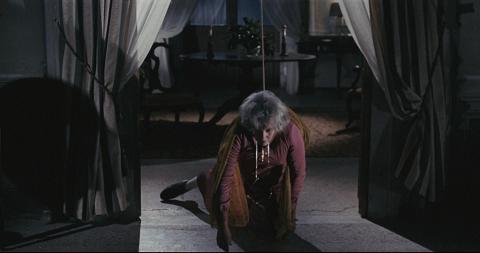
And yet, none of this answers the question, why the enduring popularity? One the one hand, as DVDs and 35mm prints of these films become increasingly available, American audiences are able to discover what Italian audiences already knew: even the worst giallo has something going for it. The bright colors and vibrant landscapes of the giallo are a welcome reprieve from the gritty darkness of contemporary horror films; similarly, the playfulness of Morricone or the funk of Goblin epitomize a sound that many contemporary composers are still trying to remake. While not well-known at the time, contemporary audiences have gained a great deal of respect for the directors, actors, and musicians who populate these films.

The giallo has also proven itself to be a particularly interesting place for gender and sexual representation. Certainly, the genre is not without its fair share of homophobic or misogynistic depictions, but whereas many genre films adhere rigidly to these stereotypes, the giallo breaks them down with glee. Because these films often link back to childhood trauma, the average giallo downplays the links between gender and sexuality and the murder in favor of an underdeveloped sense of self. The giallo is often about people who cannot fully tell the difference between the living and the dead, which, in a roundabout way, gives many of its characters an agency they would not otherwise possess. A killer can be a killer and not have it say anything significant about their gender or sexual orientation.

Welcome to Giallo Week at DailyGrindhouse!
— MATTHEW MONAGLE.
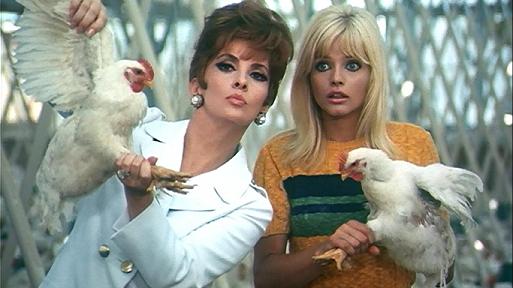
- [THE BIG QUESTION] WHAT’S YOUR FAVORITE FEMALE ENSEMBLE IN MOVIES? - July 22, 2016
- [IN THEATERS NOW] THE BOY (2016) - January 24, 2016
- Cult Movie Mania Releases Lucio Fulci Limited Edition VHS Sets - January 5, 2016
Tags: Alan J. Pakula, Columns, dario argento, Ennio Morricone, Giallo, Giallo Week, Goblin, Italy, john carpenter, Lucio Fulci, mario bava, Matthew Monagle, New York City, Screenings, Sergio Martino, Sex, violence

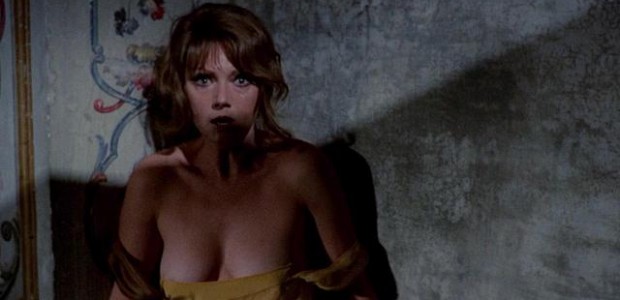




While on the whole this is a decent overview I think you are a little wide of the mark when you consider giallo in terms of genre. Though you hint at why genre itself is a problematic way to characterise giallo when you ponder conventions. Compared to vampire films for example. You see when you consider post-war Italian film it is worth considering it in terms of filone. This is a far looser concept than genre and probably more accurately reflects the development of Italian cinema. Filone, of course, is sort of a combination of both genre and wave. More of a current of cinema than a firm classification of film. Indeed a particular film current may move through a number of genres as was the case with giallo. They begin life as Hitchcockesque thrillers, but the wave passes through gothic horror, poliziotteschi, comedy, slashers and even, later on, erotic thrillers of the sort that Zalman King was responsible for in the US.
Without this broader way of considering giallo it becomes almost impossible to joint the dots between Orgasmo, Dirty Pictures, The Embalmer, The Killer Must Kill Again, Footprints, Pyjama Girl Case, Forbidden Photos and more stereotypical gialli such as Case of the Bloody Iris or other blade and glove type fare.
Possibly the best introduction to filone I’ve come across on the net is here: http://offscreen.com/view/genealogy_filone
Hi there!
First, thanks for the comment. You’re right about the filone – I’ve read Dr. Koven’s book (he was even kind enough to do an interview with me: http://paracinema.net/2012/10/qa-with-author-mikel-koven/) and I do agree that the word ‘genre’ isn’t the perfect encapsulation of this type of film. However, for people who may be unfamiliar with the giallo, I would hope that the idea of the “conversation” that I mentioned – that the films were part of an ongoing, developing exchange of cinematic sex and violence – would convey the broader ideas that I was trying to convey.
Thanks for reading, and I hope you’ll stick around this week!
I think the ongoing conversation covers it. Indeed, that even is probably a cleverer way to look at it. After all, if filone gives a particular thing a name then ongoing conversation describes a process itself. Dialectically.
I only brought the whole filone thing up because I think outside of the Italian tradition we all get hung up on genre and definitions. But the Italians clearly didn’t work that way. Even things like Westerns, which outside of Italy would easily fit a genre. Westerns in Italy would often be costumed to be something else- Macaroni combat, poliziotteschi, etc. But I find genre is especially difficult to fit with giallo. I know when trying to explain giallo to others that I too often say “sometimes”, “often”, “usually” “sort of” and so on.
I wouldn’t dare suggest that you were wrong to focus on genre, by the way. That’s not why I brought filone up in the first place. I suppose there are criteria we could come up with to fit all giallo into- after Blood and Black Lace and now Troy’s book that I’ve yet to order, had to know what to films include and what to leave out.
I suppose it gets even trickier when considering non-Italian giallo. That’s where I get puzzled. My question (to myself) is this: how come do Italian giallo defy characterisation yet when we consider non Italian giallo we manage to recognise them and they are pretty much always stereotypical giallo. So, for example, we say that Assault is a British giallo but don’t get into debates about whether we consider America’s Act of Vengeance a giallo. For example.
Maybe it’s because even though filone is perfect for describing Italian film it doesn’t work for the films traditions of other countries. So then we have to use genre. So maybe non Italian giallo have to be murder mystery films. Whereas in Italy, less so: some have no murders, or mystery at all. Anyhow, I’m off on tangents here. I’ll just say I’m looking forward to following the series. Anything that relates to Italian film is a winner in my book!